John Hurrell – 24 July, 2019
Garcia-Alvarez is obviously intrigued by obtusely-angled long lines of colour hovering in space, and what happens when they cross over, pass under, break and change vector-angle, or join up. It's an interest he had before leaving California for New Zealand in late 1972. The reproduced drawings (one with holes cut into the paper) accompanying an informative essay by ex-dealer Petar Vuletic show that.
This is a varied assortment of Alberto Garcia-Alvarez paintings: fifteen skinny wall reliefs of two or three painted wooden batons set at unexpected angles; one with a small silvery reflective rectangular panel included in order to catch and blur the coloured planes facing the wall—but hidden from the viewer; one other relief made of much thicker wood and heavier than the others; a largish painting of thick black zigzagging lines on paper (like a black net thrown over a sea of encrusted paint); and four other painted canvases and aluminium panels in the office out back.
Despite the overall variation, this is actually a focussed exhibition—especially in the main gallery—presenting a cohesive range of delicate wooden constructions, where intricate planes (long and short) reveal their colour as you slowly walk around them.
Sometimes the paint is metallic and silver, unstable in its propensity to rapidly change tone according to the light. On other occasions chromatic hues are applied and ground back to look corroded, flaked and atrophied. Nothing is slick, immaculate or industrial. Traces of the artist’s hand are everywhere. There is no irony, only the very apparent pleasure of making.
Garcia-Alvarez is obviously intrigued by obtusely-angled long lines of colour hovering in space, and what happens when they cross over, pass under, break and change vector-angle, or join up. It’s an interest he had before leaving California for New Zealand in late 1972. The reproduced drawings (one with holes cut into the paper) accompanying an informative essay by ex-dealer Petar Vuletic show this.
Some configurations hover and advance out from the wall, others recede, while a few tilt or buckle. When two colours meet or overlap certain hues are dominant. They upstage or suck the life out of any competition. Colours here are rivals that jostle for optical and spatial supremacy through hue choice or tone, and extension along each attached or overlaid wooden strip is significant.
You could call these works ‘painted sticks’ but that underplays the thickness of their line. Devalues it. Their width is as crucial as their length.
A couple of the more vertical reliefs (2018-109 A, 2018-109 B) directly reflect the twitchy and abruptly angled ‘net’ painting on the end wall in the big space. Another of the more vertical works (2018-111) has tiny thin strips (painted blue and orange) glued to the batons to form rhythmic accentuations within the decending linear flow of the piece—subtle flurries of exuberance.
Narrow planes often change colour when passing underneath another baton (2015-105 Gloria; 2017-107). Sometimes where a baton is placed on top of a right-angled intersection, the colour is altered in that slivered protected (sheltered) ‘pocket’ (2014-102) or the outer baton is sliced into exposing the right-angle (2018-110 XVII) so it can be seen far away from the wall.
These Garcia-Alvarez relief works engross through their spatial perplexity. There is much to chew over. They occupy a zone in between (say) the work of Don Peebles‘ ‘Pasmore’ period and the inventively painted ‘frame’ works of Tomislav Nikolic, but entirely liberated from the rectangle. Clusters that extol the pleasures of bodily movement accompanied by close and repeated ocular examination.
John Hurrell
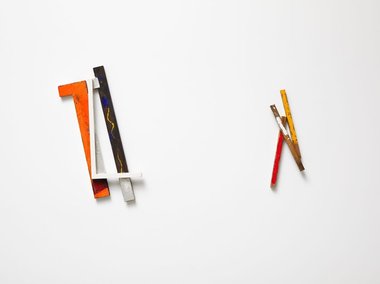





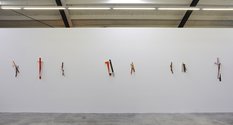


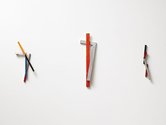
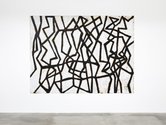
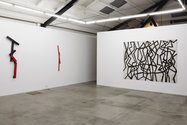




 Advertising in this column
Advertising in this column Two Rooms presents a program of residencies and projects
Two Rooms presents a program of residencies and projects



This Discussion has 0 comments.
Comment
Participate
Register to Participate.
Sign in
Sign in to an existing account.